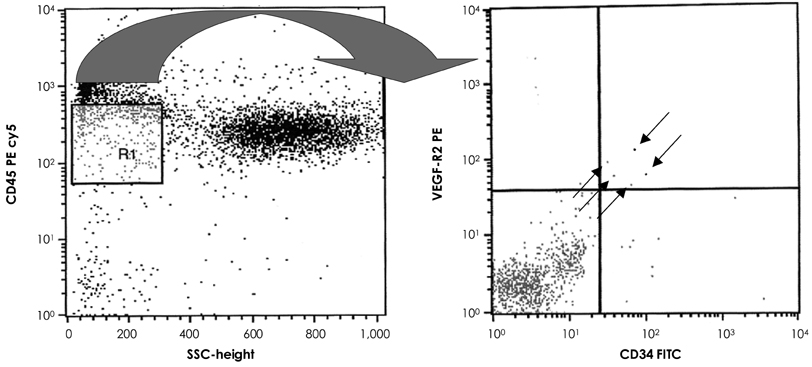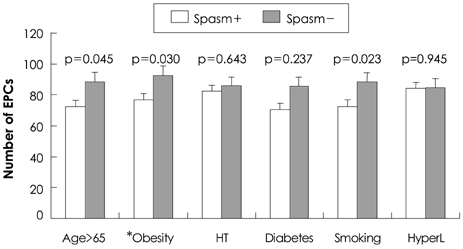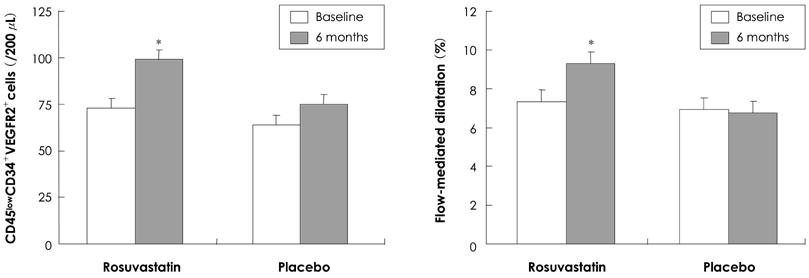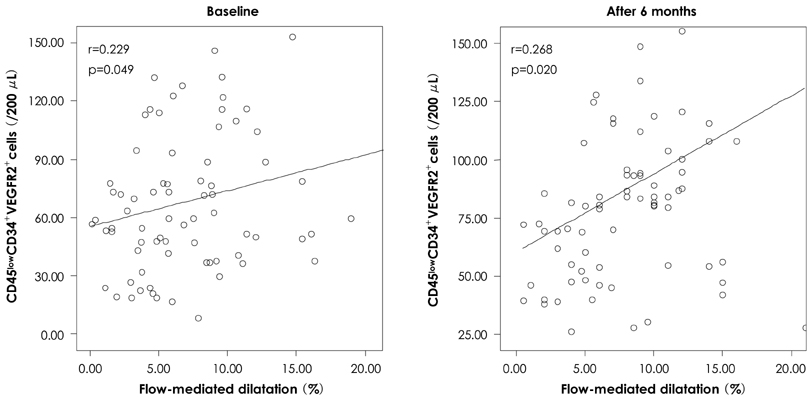Effect of Additional Statin Therapy on Endothelial Function and Prognosis in Patients With Vasospastic Angina
- Affiliations
-
- 1Department of Cardiovascular Medicine, Wonkwang University Hospital, Iksan, Korea. ards7210@wonkwang.ac.kr
- KMID: 2225696
- DOI: http://doi.org/10.4070/kcj.2008.38.12.638
Abstract
- BACKGROUND AND OBJECTIVES
Vasospastic angina is correlated with endothelial dysfunction. We compared endothelial function using flow-mediated vasodilatation (FMD) and circulating endothelial progenitor cells (EPCs) between patients with vasospasm and those without vasospasm and studied the effect of statin therapy on the changes of FMD and EPCs in vasospastic angina patients. SUBJECTS AND METHODS: In 133 patients who underwent an ergonovine provocation test, endothelial function was compared based on the presence or absence of spasm. The patients with coronary artery spasm (74 patients) were randomly assigned to either the 10 mg rosuvastatin group or the placebo group. We compared changes in the FMD and EPCs level for 6 months from the time of enrollment between the two groups. RESULTS: The incidence of cigarette smokers was higher in vasospastic angina patients than in those without spasm (p<0.001). The number of EPCs (68.6+/-36.1 vs. 103.7+/-39.3/200 microliter, p<0.001) and the FMD (7.1+/-4.5 vs. 8.6+/-3.6%, p=0.044) were significantly lower in patients with coronary artery spasm than in those without spasm. After 6 months of rosuvastatin treatment, the number of CD45(low)CD34(+) vascular endothelial growth factor receptor 2 (VEGFR2)(+) cells, which was defined as EPCs, increased significantly from 73.1+/-37.8/200 microliter to 99.1+/-37.8/200 microliter (p=0.002). The FMD was significantly ameliorated from 7.3+/-4.1 to 9.3+/-3.4% after 6 months of treatment (p<0.001). The FMD was correlated with the EPCs count before treatment (r=0.229, p=0.049) and after 6 months of treatment (r=0.268, p=0.020). CONCLUSION: The number of circulating EPCs and the FMD were reduced in vasospastic angina, and statin treatment increased the number of EPCs and the FMD. The EPCs level was correlated with the FMD.
MeSH Terms
-
Coronary Vasospasm
Coronary Vessels
Endothelium
Ergonovine
Fluorobenzenes
Humans
Incidence
Prognosis
Pyrimidines
Spasm
Stem Cells
Sulfonamides
Tobacco Products
Vascular Endothelial Growth Factor Receptor-2
Vasodilation
Rosuvastatin Calcium
Ergonovine
Fluorobenzenes
Pyrimidines
Sulfonamides
Vascular Endothelial Growth Factor Receptor-2
Figure
Cited by 2 articles
-
Effects of Low Dose versus High Dose Statin Therapy on the Changes of Endothelial Function and Carotid Intima-Media Thickness in Patients with Variant Angina
Kye Hun Kim, Sook Hee Cho, Yi Rang Yim, Kyung Jin Lee, Ju Hyup Yum, Hyun Ju Yoon, Nam Sik Yoon, Young Joon Hong, Hyung Wook Park, Ju Han Kim, Youngkeun Ahn, Myung Ho Jeong, Jeong Gwan Cho, Jong Chun Park
J Cardiovasc Ultrasound. 2013;21(2):58-63. doi: 10.4250/jcu.2013.21.2.58.Characteristics of Patients with Vasospastic Angina in Korea: Data from a Large Cohort (VA-KOREA)
Sung Eun Kim, Sang-Ho Jo, Won-Woo Seo, Min-Ho Lee, Hyun-Jin Kim, Seong-Sik Cho, Kwan Yong Lee, Dong-Soo Kim, Tae-Hyun Yang, Sung-Ho Her, Seung Hwan Han, Byoung-Kwon Lee, Youngkeun Ahn, Seung-Woon Rha, Hyeon-Cheol Gwon, Dong-Ju Choi, Sang Hong Baek
Cardiovasc Prev Pharmacother. 2021;3(3):47-53. doi: 10.36011/cpp.2021.3.e8.
Reference
-
1. Hillis LD, Braunwald E. Coronary-artery spasm. N Engl J Med. 1978. 299:695–702.2. Suzuki H, Kawai S, Aizawa T, et al. Histologic evaluation of coronary plaque in patients with variant angina: relationship between vasospasm and neointimal hyperplasia in primary coronary lesions. J Am Coll Cardiol. 1999. 33:198–205.3. Miwa K, Igawa A, Inoue H. Soluble E-selectin, ICAM-1 and VCAM-1 levels in systemic and coronary circulation in patients with variant angina. Cardiovasc Res. 1997. 36:37–44.4. Terashima M, Akita H, Kanazawa K, et al. Circulating T-lymphocyte activation in patients with variant angina. Coron Artery Dis. 2002. 13:161–168.5. Yun KH, Oh SK, Park EM, et al. An increased monocyte count predicts coronary artery spasm in patients with resting chest pain and insignificant coronary artery stenosis. Korean J Intern Med. 2006. 21:97–102.6. Kugiyama K, Murohara T, Yasue H, et al. Increased constrictor response to acetylcholine of the isolated coronary arteries from patients with variant angina. Int J Cardiol. 1995. 52:223–233.7. Asahara T, Murohara T, Sullivan A, et al. Isolation of putative progenitor endothelial cells for angiogenesis. Science. 1997. 275:964–967.8. Gehling UM, Ergun S, Schumacher U, et al. In vitro differentiation of endothelial cells from AC133-positive progenitor cells. Blood. 2000. 95:3106–3112.9. Vasa M, Fichtlscherer S, Aicher A, et al. Number and migratory activity of circulating endothelial progenitor cells inversely correlate with risk factors for coronary artery disease. Circ Res. 2001. 89:E1–E7.10. Hill JM, Zalos G, Halcox JP, et al. Circulating endothelial progenitor cells, vascular function, and cardiovascular risk. N Engl J Med. 2003. 348:593–600.11. Vasa M, Fichtlscherer S, Aicher A, et al. Increase in circulating progenitor cells by statin therapy in patients with stable coronary artery disease. Circulation. 2001. 103:2885–2890.12. Thum T, Tsikas D, Stein S, et al. Suppression of endothelial progenitor cells in human coronary artery disease by the endogenous nitric oxide synthase inhibitor asymmetric dimethylarginine. J Am Coll Cardiol. 2005. 46:1693–1701.13. Igarashi Y, Yamazoe M, Shibata A. Effect of direct intracoronary administration of methylergonovine in patients with and without variant angina. Am Heart J. 1991. 121:1094–1100.14. Sueda S, Kohno H, Fukuda H, et al. Clinical impact of selective spasm provocation tests: comparisons between acetylcholine and ergonovine in 1508 examinations. Coron Artery Dis. 2004. 15:491–497.15. Kondo T, Hayashi M, Takeshita K, et al. Smoking cessation rapidly increases circulating progenitor cells in peripheral blood in chronic smokers. Arterioscler Thromb Vasc Biol. 2004. 24:1442–1447.16. Koh KK, Quon MJ, Han SH, et al. Additive beneficial effects of losartan combined with simvastatin in the treatment of hypercholesterolemic, hypertensive patients. Circulation. 2004. 110:3687–3692.17. Shin DI, Seung K, Kim DB, et al. Comparison of the long-term prognosis between coronary vasospasm and intermediate vasoconstriction induced by the administration of acetylcholine. Korean Circ J. 2006. 36:503–509.18. Walter DH, Rittig K, Bahlmann FH, et al. Statin therapy accelerates reendothelialization: a novel effect involving mobilization and incorporation of bone marrow-derived endothelial progenitor cells. Circulation. 2002. 105:3017–3024.19. Rafii S, Lyden D. Therapeutic stem and progenitor cell transplantation for organ vascularization and regeneration. Nat Med. 2003. 9:702–712.20. Gill M, Dias S, Hattori K, et al. Vascular trauma induces rapid but transient mobilization of VEGFR2(+)AC133(+) endothelial precursor cells. Circ Res. 2001. 88:167–174.21. Werner N, Kosiol S, Schiegl T, et al. Circulating endothelial progenitor cells and cardiovascular outcomes. N Engl J Med. 2005. 353:999–1007.22. Bonetti PO, Lerman LO, Napoli C, Lerman A. Statin effects beyond lipid lowering: are they clinically relevant? Eur Heart J. 2003. 24:225–248.23. Karatzis E, Lekakis J, Papamichael C, et al. Rapid effect of pravastatin on endothelial function and lipid peroxidation in unstable angina. Int J Cardiol. 2005. 101:65–70.24. Dogra GK, Watts GF, Chan DC, Stanton K. Statin therapy improves brachial artery vasodilator function in patients with Type 1 diabetes and microalbuminuria. Diabet Med. 2005. 22:239–242.25. Lee Y, Kim K. The short-term effect of atorvastatin on flow-mediated vasodilation, pulse wave velocity and carotid intima-media thickness in patients with moderate cholesterolemia. Korean Circ J. 2008. 38:144–151.
- Full Text Links
- Actions
-
Cited
- CITED
-
- Close
- Share
- Similar articles
-
- Diagnostic Significance of ECG Ergonovine Provocation Test in Patients with Vasospastic Angina
- Effects of Low Dose versus High Dose Statin Therapy on the Changes of Endothelial Function and Carotid Intima-Media Thickness in Patients with Variant Angina
- Exercise-Induced Vasospastic Angina With Prominent Regional Wall Motion Abnormality
- Recent Insights Into the Mechanisms of Vasospastic Angina
- The Vasomotor Tone In Vasospastic Angina





